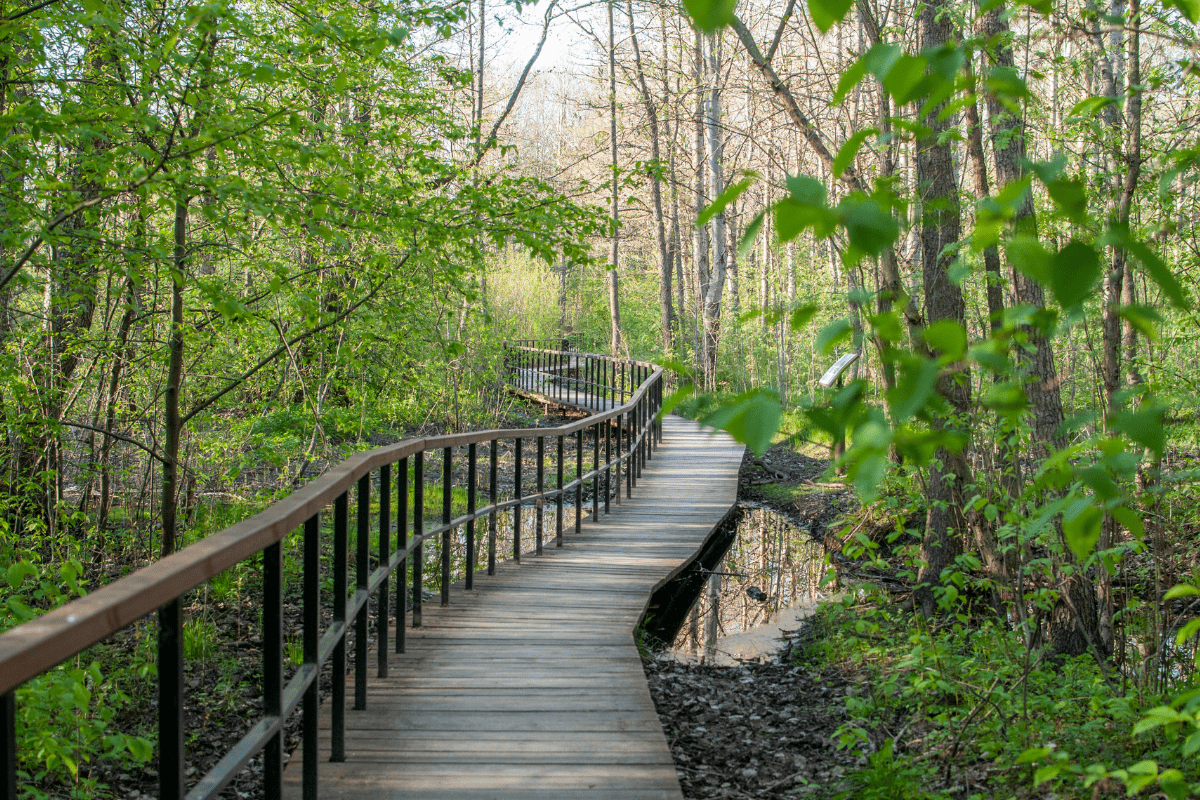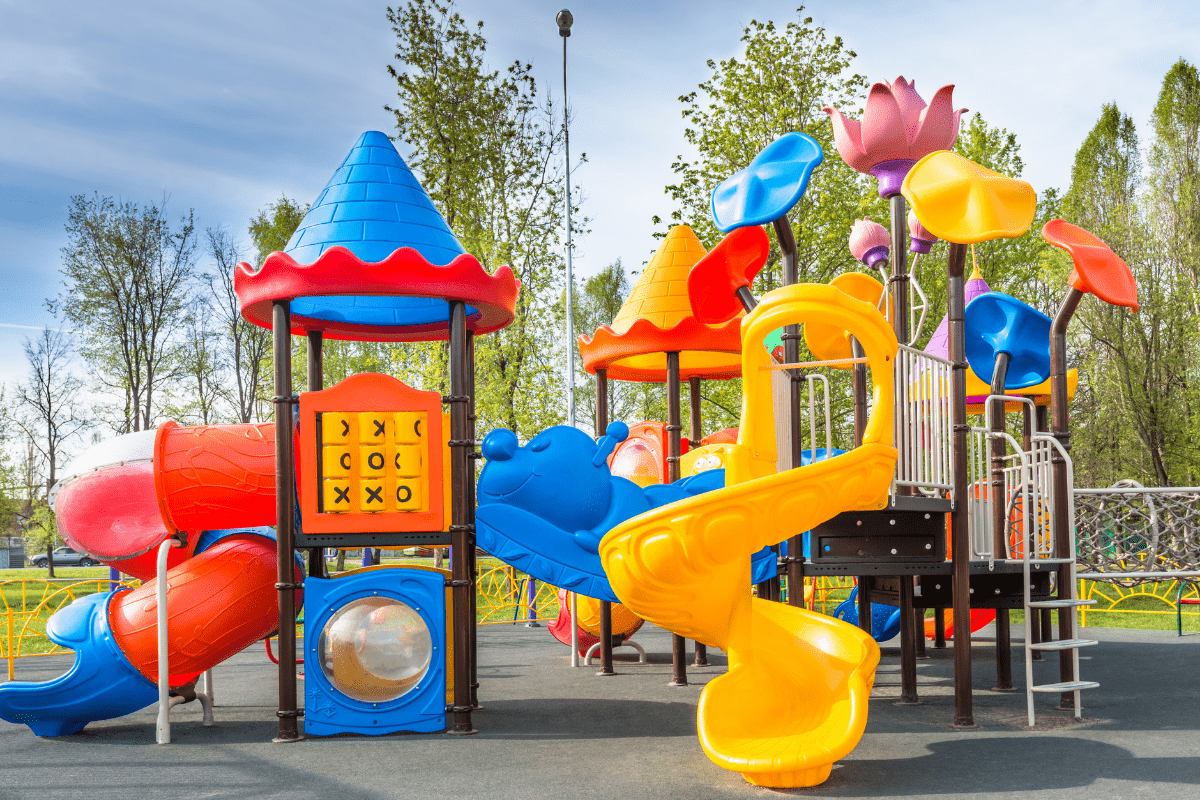If you’re craving lush forests, waterfall views, and peaceful meadows, the Eastside area has a trail for every pace and mood. From easy strolls with family to sweat-inducing climbs, local parks and preserves make it simple to trade traffic for birdsong.
Let’s get to it.
Farrel-McWhirter Park
Farrel-McWhirter Park offers a relaxed 68-acre setting ideal for families, grandparents, and dogs that enjoy exploring. The main loop trail stretches about 1.25 miles and stays mostly flat with dirt, gravel, and occasional woodchips underfoot. You’ll find gentle slopes rather than steep climbs, making it easy on all ages.
Along the way, you pass a working barnyard where farm animals go about their day. Kids and animal lovers often linger to watch goats, sheep, and chickens. The trail weaves through shaded woods and open meadows. In spring, wildflowers brighten the fields and birds fill the air with song. A few small stream crossings add variety, and winter mud patches remind you to wear proper footwear.
Parking is free and restrooms are conveniently located. Several picnic shelters include electricity and water, and benches appear at regular intervals. Leashed dogs are welcome, though you may spot some off-leash rule-breakers. Overall, the park leans toward laid-back exploration and is kept in good condition by city maintenance crews.
Redmond Watershed Preserve
At Redmond Watershed Preserve, multi-use trails truly live up to their name. Across roughly seven miles, you’ll share the path with hikers, mountain bikers, and even horseback riders. Signs make it clear dogs aren’t allowed, so leave Fido at home. Most visitors follow the four-mile main loop, which climbs about 400 feet. It’s easy enough for beginners yet satisfying for seasoned hikers. For a shorter outing, the Treefrog Loop winds past ponds and wetlands and includes a smooth, paved boardwalk that’s ADA accessible. Benches and a small viewpoint let you pause while trillium blooms in spring.
Facilities here feel surprisingly modern. Restrooms feature running water, and water fountains dot the route. Large parking areas accommodate cars and horse trailers. Maps at key intersections help you stay on course. Expect moderate crowds on weekends, and you might spot rangers making the rounds in summer. The trails are well maintained, but keep an eye out for roots and rocks, especially on the soft dirt spurs used by equestrians. After rain, be ready for mud and puddles, but wildflowers often reward the effort.
Paradise Valley Conservation Area Parking and Trail Head
The Paradise Valley Conservation Area Parking and Trail Head serves up roughly 13 miles of unpaved dirt trails through forest and wetlands. You’ll cross rocky streambeds, hop over small logs, and enjoy gentle elevation changes that suit hikers, mountain bikers, and equestrians alike. County rules require dogs on leash, so be prepared to reel yours in if they spot wildlife.
Parking is free but limited, especially on weekends when horse trailers and bikes arrive early. No permit is needed, and maintenance by county crews and volunteers keeps the main routes clear. Facilities are basic: one portable toilet stands at the trailhead, and there’s no running water or benches unless you bring your own. Winter and early spring bring muddy sections, so gaiters or extra socks help. Pack out all trash and plan to carry in everything else. This area delivers raw, unpolished outdoor access without pretense.
Bridle Trails State Park
Bridle Trails State Park offers 28 miles of packed-dirt loops under a canopy of Douglas firs and huckleberry bushes. Horseback riders share right-of-way with hikers and joggers, so keep an eye out for mounted visitors. The level terrain and minimal hills make it easy on all skill levels, though exposed roots can be a tripping hazard.
A large parking area accommodates trailers and vehicles, and you’ll find picnic tables and barbecue spots near trailheads. Wildlife sightings include deer, ravens, and an array of songbirds weaving through the trees. ADA parking and flat trailhead areas improve access, but the paths themselves aren’t fully wheelchair-friendly. Leashed dogs are allowed, though you may find yourself detangling as horses pass. Trails are well marked, so getting lost is unlikely. Bridle Trails State Park strikes a balance between equestrian tradition and everyday outdoor recreation.
Kelsey Creek Park
In Kelsey Creek Park, what looks like a simple neighborhood green space quickly expands into a historic farm scene, forested trails, and a wetlands boardwalk. The 1.7-mile Kelsey Creek Nature Trails circuit takes you through mixed woods, open meadows, and a wetland with a deep, bowl-shaped feel. You’ll cross small creeks, find benches at quiet spots, and spot wildflowers in spring. After heavy rain, some sections get muddy, so plan accordingly.
For a paved option, try the Kelsey Creek Pipeline Trail. This 2.5-mile out-and-back route is smooth enough for strollers and wheelchairs. While there are no restrooms on the pipeline, benches appear at intervals. Leashed dogs are welcome but should stay clear of farm animals. Trails are calm on weekdays and busier on weekends when families and joggers arrive. Signage is clear, and city maintenance keeps everything in good shape.
Perrigo Park
Over in Perrigo Park, you get a neat mix of paved paths, open fields, and low-key amenities. A half-mile paved loop circles soccer fields and green spaces with just 13 feet of elevation gain. Strollers, wheelchairs, and leashed dogs all navigate the path easily. Benches and picnic tables are spread along the way for anyone who prefers a rest to extra miles.
From that loop, you can branch onto the Evans Creek Trail. This almost two-mile stretch of wide asphalt runs beside farmland and natural habitat patches. It’s popular but rarely crowded thanks to its generous width. Restrooms are on site, and the parking lot includes ADA-ready stalls plus van-accessible spaces. The park stays open year-round and maintenance is reliable. Whether you want a quick stroll or a longer outing, Perrigo Park delivers solid paths and basic comforts without fuss.
Juanita Bay Park
At Juanita Bay Park, you’ll find a blend of city park features and unspoiled wetland habitat that really works. The trails are truly easy, with options like the Old Market Street Trail (1.2 miles out and back) and several gentle loops where you barely break a sweat. Strollers, wheelchairs, families, and solo walkers all share raised cedar boardwalks and paved sections that keep your shoes dry and your pace steady.
Lake Washington stretches wide at various viewpoints, while seasonal wildflowers and lily pads dot the water’s edge. Forbes Creek offers another scenic angle. Ducks, turtles, beavers, and raptors all make regular cameos, and benches are strategically placed for wildlife watching. Restrooms are available in warmer months, so check before you arrive. Avoid visiting right after heavy rain if you’d rather not test your boots. Parking can fill up, especially on weekends, so arriving early is wise. Despite limited space, the lot usually works out. Overall, Juanita Bay Park makes the most of a small wetland area without feeling overdesigned.
O. O. Denny Park
O. O. Denny Park spans 45 acres along Lake Washington and balances forest trails with beach access. Towering old-growth Douglas-fir trees and cottonwoods rise above ferns and understory plants. A short 0.8-mile loop trail features stair steps, exposed roots, and slight climbs that keep the walk engaging.
Paved paths lead from parking areas to picnic tables and a playground. A modest stretch of shoreline invites visitors to pause by the water. Seasonal restrooms open when crowds arrive, and two parking lots fill up quickly on sunny weekends.
After rain you may encounter patches of squishy dirt, so waterproof footwear is wise. The main developed trails suit strollers and wheels, but deeper loops become narrow and root-strewn. Dogs join walkers on a leash, and pet waste stations appear near trailheads. If skies clear, you might spot Mount Rainier in the distance from benches placed along the forested trails.
Poo Poo Point Trailhead
Poo Poo Point Trailhead marks the start of a famous 7.2-mile out-and-back hike in the Issaquah Alps. Hikers gain roughly 1,800 feet in elevation, so expect steady switchbacks that test your endurance. The trail weaves through stands of Douglas-fir and western hemlock, and spring brings wildflowers along the route.
After the final ascent, sweeping views open up across Snoqualmie Valley and the Cascade Range. On clear days you may even glimpse the Olympic Mountains. Sunrise and sunset hikes add drama as light spreads across the peaks.
The dirt path remains mostly well-maintained, though roots and rocks demand careful footing. Steep sections mean this route is off-limits to strollers and wheelchairs. Parking at the trailhead holds about 30 vehicles and fills early on sunny weekends. You’ll find a vault toilet and an information kiosk, but no water taps. Carry all essentials. Leashed dogs are permitted, and trail crews work year-round to keep mud and ice manageable.
Grass Lawn Park
Grass Lawn Park in Redmond manages to serve many needs without feeling crowded. The paved loop trail wraps around 1.1 miles of mostly flat ground. It remains ADA accessible, so strollers and wheelchairs move easily. Mature trees edge the path, offering shade during hot afternoons.
Beyond the trail, open green fields invite games or relaxation. Well-maintained restrooms and two parking lots make it simple to plan a picnic. Water fountains and benches appear throughout the park. Nearby sports courts support basketball, tennis, and other activities.
Families appreciate the clean playground area, and leashed dogs are welcome on the main paths. On busy days you’ll see neighbors enjoying time outdoors rather than large crowds. Park staff tend to landscaping all year, keeping grass trimmed and facilities in good shape. Overall, Grass Lawn Park offers a straightforward and comfortable outdoor escape close to home.
Marymoor Park
Marymoor Park blends a wide range of outdoor options across its spacious grounds. You’ll find walking and biking routes, sports fields for soccer and baseball, a velodrome for bike racing, a climbing wall, a boathouse, and active community gardens tended by volunteers.
The popular Marymoor Connector Trail is a smooth 1.6-mile paved path. It accommodates strollers, wheelchairs, and scooters. Cyclists share the route, and dogs trot alongside their owners, especially in the afternoon. This trail remains open to the sun, so bring water on warm days.
For a longer outing, the Marymoor Park Loop Trail stretches over six miles around Lake Sammamish. It moves between forest dirt and paved sections, passing wetlands dotted with wildflowers. The terrain is never too rough, though you may step over roots. You can park for one dollar, use restrooms, and pause at picnic tables.
The Audubon BirdLoop Trail covers just half a mile. Boardwalks cross the marsh and interpretive signs help you spot local birds. It stays dry underfoot and welcomes strollers, making it a gentle stroll year-round.





